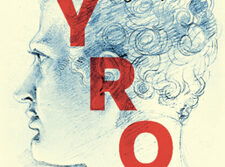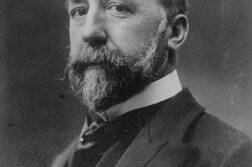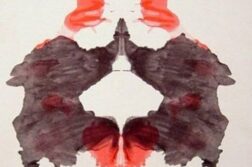The following is excerpted from Gay Tourism: Culture and Context, published by Haworth Press, 2006. Reprinted with permission.
TOURISM IS SHAPED by powerful popular cultural mythologies, and gay tourism is no different in this regard. For same-sex-attracted men living in Britain and other northern European nations throughout the 19th and into the early 20th centuries, a powerful mythology concerning “homosexual” relations in southern Mediterranean countries such as Italy and Greece had considerable currency and may have influenced many who had the means to travel there—the imagined cultural geography of classical homosexuality. The homosexual visitors to these southern Mediterranean regions may have been influenced by an imagined geography circulated through classical understandings of homosexuality in their search for a kind of Arcadia where homosexual love and lust could be played out without fear of persecution for the crime of sodomy. Homeric Greek culture was valued by poets of the British Romantic movement to provide idealized articulations of male-male “friendships” as “pure,” “perfect,” and “spiritual” to counter the hostility toward male homosexuality that was endemic in Georgian and Victorian society (Bravmann, 1994).
In the 1800’s, Italy was the Mediterranean country that attracted the most European visitors, regardless of sexuality: access to it was comparatively straightforward (unlike Greece, Spain, and Portugal). Italy’s cultural life, both past and current, was considered to be emblematic of Western civilization itself, and it boasted a wealth of art galleries and museums as well as ancient ruins, both classical Greek and Roman. Southern Italy in particular appealed to homosexual travelers in that it promised a more “natural” sexuality that had not been tempered by the restrictions placed upon it by northern European civilization. Apparently, “In the eyes of the northerners, the Italians—little different from primitive people overseas—were natural, spontaneous, open and able to live out their sexuality, just as in ancient Greece or Rome” (Aldrich, 1993). Thus by the late 1800’s a number of places in southern Italy developed reputations as incipient homosexual “resort” towns, including Capri in the Bay of Naples, Taormina in Sicily, Palermo, and Naples. Capri, in particular, had acquired an image as a homosexual “Eden,” in part because of its climate, its landscape, and its apparently attractive youths. These themes were later celebrated in a variety of novels and photographs published in the early 1900’s. Prominent homosexual writers and poets such as August von Platen, Hans Christian Andersen, and André Gide took holidays there, which no doubt helped to confirm its reputation.

Northern European writers, artists, and photographers of the 19th century framed and objectified the men and youths of southern Italy within an “exotic otherness” of a mythical ancient Greece. Robert Aldrich outlined this process as follows:
While the writers, painters and photographers treat the Italians (or Greeks or other Mediterraneans) in a heroic way, exalting their beauty and turning them into figures from Antiquity, they almost always depersonalize them. They become, at worst, simply handsome young studs and, at best, loyal retainers, brave freedom-fighters or the majestic heirs of classical beauty and ancient virtues.
Despite the depersonalization and objectification, which is still clearly evident in contemporary male erotic imagery and texts, these representations were, and still are, powerful tools in the construction of homosexual or gay identities for certain destinations that helped unsettle heteronormative identities. The works of the German photographers Wilhelm von Gloeden (1856–1931) and Wilhelm von Plüschow (1852–1930) did much to popularize and promote Mediterranean Europe as a kind of homosexual utopia. Images were exclusively of adult or adolescent boys and transvestites, often produced as picture postcards and later shown in magazines. Gender confusion was clearly part of the Victorian erotic thrill. These images helped to showcase certain destinations, such as Sicily, as being of considerable interest to homosexual men for their “deviant celebrations of taboo desire” (Waugh, 1996), just as today’s erotica in videos and magazines continues to play an important role in shaping destination images and desires.
A number of legal, cultural, and social factors also facilitated homosexual contact between northern and southern Europeans in Italy. For one thing, at that time homosexual activity was not a criminal act in Italy or in other Napoleonic Code nations such as France and Spain. Yet the Catholic Church did actively regulate and control social and individual behavior through moral censure, what Giovanni Dall’Orto terms a “repressive tolerance.” Dall’Orto has suggested that homosexuals could do what they liked in private as long as they didn’t adopt a blatant, public lifestyle that overtly challenged orthodox beliefs and practices. For homosexual tourists in the Mediterranean region, much of their socializing centered on lunches and dinner parties at the homes of individual expatriates and in their rented villas, as well as in some cafés and restaurants. Informal friendship networks would have been the primary means of obtaining access to such events. But at least for the wealthier or more famous guests who holidayed at destinations such as Capri, one did not necessarily conduct one’s social life entirely away from the gaze of others. Aldrich remarks that while “the homosexuals were only a small proportion of the 40,000 tourists who arrived in Capri each year by 1910 … they were among the most visible and most devoted of visitors and residents.” Many tourists and their guests, particularly those from privileged social backgrounds, chose to participate in the mainstream social circles of Capri, as well as the dinner parties and other engagements meant for a more “select” circle.
In addition, sex was understood more in terms of the roles of the penetrator and the penetrated than heterosexual and homosexual. An adolescent male’s masculinity remained intact when engaging in homosexual contact provided he took the active, insertive role in anal intercourse. Much of the sexual contact between tourists and hosts also had a financial basis, making it a different form of sexual activity from sex between equals. Travel southward for these Northern European men was a means to escape oppressive laws and cultures and to enjoy social and sexual opportunities that were far more difficult to achieve at home. As Aldrich remarked: “Some awoke to their ‘deviant’ desires only when they went abroad, others allowed themselves sexual license solely when they were overseas—still others—their moral dilemmas resolved—journeyed to or lived in the South assured of the pleasures they anticipated. Going abroad was the way many homosexuals ‘came out’ and the desire to go abroad linked with a homosexual’s self-realization.” Bleys (1993) has argued that homosexual men also traveled as a means of resistance to a conventional, sedentary lifestyle centered on the nuclear family, a stable career, and home ownership: “[t1he nomadic desire, finally, is an aspiration to a sociality that is amorphous, temporary, orgiastic and atomic.” Tourism thus became a conspicuous means of asserting difference from heteronormative expectations and assumptions. In fact, in the 1800’s many upper-class European homosexual men who traveled abroad, whether to the Mediterranean or to other regions, decided to remain there, living an expatriate life, as did Lord Byron, for example.
Narratives of the Orient
Edward Said (1978) argued notably that the West has appropriated the so-called “East” in order to project onto it an otherness that mirrors Western fantasies of illicit sexuality and unbridled excess. Sir Richard Francis Burton (1821–1890), Victorian explorer and writer, circulated the stereotype of Eastern “perversity” that might appeal to a homosexual audience in the mid-1800’s because of its homoeroticism. Although he was reputedly sexually interested in men himself, he was very clear that he viewed homosexuality as “un-British.” In 1885, he made headline news when he published his scandalous “Terminal Essay,” addressing a number of “interpretive” issues related to his translation of the anonymous Arabian classic, The Arabian Nights. In this essay, which was removed by the publishers from later editions, he expounded his theory on the origins of homosexuality using the terms “vice,” “inversion,” and “pederasty.” He mapped out an area in which he argued that the “vice” was not just prevalent but endemic. This area extended from the North African countries of Morocco, Algeria, and Tunisia to Egypt and the Syrian-Arabic peninsula. He called it the “Sotadic Zone,” derived from the name of the Greek poet Sotades as a euphemism for “sexual inversion.” According to Burton, climate was seen to facilitate pathological love, not race, as argued by most of his contemporaries. Although his theory is empirically useless, he challenged Victorian public thinking that stigmatized male homosexuality and theorizing about homosexuality in terms of cultural evolution.
To what extent the public scandals created by Burton’s environmental deterministic interpretations of male homosexuality helped to bring the homoeroticism that pervades A Thousand and One Nights to the attention of homosexual men, influencing their travel to the “Sotadic Zone,” is unknown. For centuries Christianity had portrayed Islam, the religion that occupied a good part of the Sotadic Zone, as immoral because of its practice of polygamy. Imagined as Christianity’s sexual other, the Muslim world was where many homosexual Westerners expected to find some kind of sexual paradise (Weeks, 1985). Indeed the homoeroticism of Orientalism in the imagined geography of the West has fueled the work of homosexual writers, artists, photographers, and tourists, sustained by colonial discourses about brown skin, bathhouses, harems, slave markets, desert heat, and tented caravans, with an abundance of veils, robes, cushions, and youthful men thrown in.
In the 19th and early 20th centuries, North Africa and the Middle East were cherished destinations for European male writers and artists seeking to visit Oriental civilization for sexual pleasures and erotic satisfaction. Those reproducing the occidental vision of North African sexuality included Wilhelm von Gloeden, André Gide, Oscar Wilde, E. M. Forster, and T. E. Lawrence. In the 1830’s, Algeria, then a French colony, became a popular cruising ground for affluent European homosexuals. In the 1920’s, Morocco, then a French-Spanish colony, became the favored homosexual hot spot. The reputation of the capital, Tangiers, as a site of sexual opportunity was enhanced by its designation as an International Zone in 1923 (until 1956), which enabled a range of illicit activities to flourish, including sex work involving boys, drug trafficking, and monetary speculation. By the early 1950’s, Tangiers was “the world’s first and foremost gay center” (McIvor, 1994). In the period from 1950 to 1980 many affluent and celebrated American and European homosexuals made Tangiers their home or visited Tangiers as tourists. Notable expatriate or visiting gay men included William Burroughs, Paul Bowles, Jean Genet, Truman Capote, Allen Ginsburg, and Joe Orton. For many of them, Tangiers was a sanctuary, a counter-hegemonic space where they created self-affirming social networks. To be sure, the fact that they paid male youths for sex does raise questions regarding the dynamics of these relationships. Hanns Ebensten (1999), one of the earliest and most prominent gay tour operators, described one of these “boy brothels”:
Many of these boys, some as young as thirteen years, lacking friends or relatives in Tangier, found a haven in the male brothels, but the more enterprising operated on their own, or in pairs, and occupied windowless cubicles arranged like prison cells or animal cages around a central courtyard in tall tenement-like houses in the medina, each with just enough space to contain a cot or a mattress and a radio. … They were as delightful as adorable puppies, extremely clean and as splendidly endowed as reputed and with their pubic hair modestly shaved.
Like many gay tour operators, Ebensten locates the role of the tourist as a philanthropist, an economic savior, and that of the sex worker as an employee who “loves [his]work” and occupies a “traditional role” (see Chester, 1990). Furthermore, Ebensten mentioned that, on his first visit to Tangiers in 1959, he stayed in a guesthouse occupied also by “Ahmed Jacobi, the painter and lover of the American writer Paul Bowles … and Maurice Grossner, a New York photographer” (Ebensten, 1999). He had been persuaded to visit Tangiers partly by the photographs in “the society papers by Mr. Cecil Beaton, the royal photographer, of the beautiful young Mr. Truman Capote, Lord and Lady Guinness, and stunning young dark-skinned, laughing Moroccan youths on the beach of Tangier” (Ebensten, 1999).
These claims appear to support our speculation that, given the lack of commercial gay travel guides and television, significant sources helping to shape the homosexual tourists’ imagination of Tangiers in terms of homoerotic Orientalism were the expatriate population and newspaper and magazine articles accompanied by photographs of glimpses of semi-naked dark-skinned youths and, of course, the glamorous, wealthy, and famous. Word of mouth no doubt also played an important role. Ebensten (1999) remarked that Tangiers had in the 1950’s already developed a reputation as a “Mecca for homosexual men from Europe and North America.”
Although Morocco continued to appeal to gay men as a holiday destination up until the mid-1980’s, it appears that a growing conservatism stemming partly from Islamic fundamentalist attitudes toward Western tourists generally and homosexuality and sex-work more specifically has reconfigured Morocco from being a place of easily attainable sexual adventure to a place of considerable risk and danger. This shift is apparent in the Spartacus International Gay Guide, which by the late 1980’s warns gay men of the dangers there: “Morocco has become anything but a paradise for lovers of Arab boys” (Gmünder and Stamford, 1989: 566). Yet, perhaps incidentally, the past “debauched glories” of Tangiers still resonated in an episode of the gay cult comedy series Absolutely Fabulous, titled “Morocco.” When Edina mentions to her daughter Saffy about her and Patsy’s plans to spend some time in Marrakech, Saffy expresses an interest in going with them so that she can do some research on the “indigenous tribes of that region. “ Eddy admonishes her, saying, “You go to Marrakech … for drugs, cheap plates and rugs,” and, Patsy adds, “easy-going sex with gorgeous underage youths.” Homoerotic Orientalism still circulates within some Western geographical imaginings of North Africa.
Narratives of the Tropic
Just as European and North American homosexual artists, poets, and writers moved to southern Mediterranean countries and North Africa during the late 19th and early 20th centuries, some traveled to tropical colonies. For example, the German painter Walter Spies (1895–1942) arrived on the Indonesian island of Bali in 1927. Several decades later, the Australian artist Donald Friend lived in Bali from 1966 until the early 1970’s, and many of his paintings have a clearly discernible homoerotic intent.
Through the works of Spies and other artists, Bali came to be known at least in the more elite, artistic circles as a “homosexual paradise” (Vickers, 1989). Yet, Bali has not yet achieved any significant status as a gay tourist destination, notwithstanding the recent emergence of some limited gay accommodation and nightclubs, even though a large gay market existed and continues to exist in Australia and New Zealand. Bali was aggressively marketed as a holiday destination for families as part of the drive toward mass tourism in the 1970’s and thus was not particularly appealing to gay men.
Tropical Central and South America also appealed to some homosexual men, particularly those familiar with the narratives connecting these places with histories of sexual minorities. From the 1550’s through the early 1800’s, men convicted of sodomy under the Portuguese Inquisition were often exiled to Brazil (Higgs, 1999). Drucker (1996) noted that among the Portuguese and Dutch colonists in Brazil it was often said that “in the tropic there is no sin.” Hence, contrary to the colonists’ religious tenets and official policies, colonial slave-owners could force their slaves, both male and female, into sexual submission or sex work. Moreover, since the 19th century, some homosexual men have sought refuge in the transgender undergrounds that emerged with large-scale industrialization and urbanization in South American cities, particularly in Buenos Aires and Rio de Janeiro (Drucker, 1996). In the early 1900’s these cities, as those in the United States and Europe, had a transgender subculture with its own venues, dress codes, slang, and carnivals.
The modern image of Rio as a gay-scripted destination was fueled in part by the Carnival that takes place there each year, which can be traced back to earlier forms in the 1880’s. The Carnival presents possibilities for cross-dressing and sexualized fun. Rio as a gay destination was also constituted through a particular genre of Brazilian film, chanchadas, produced from the 1930’s (Higgs, 1999). Through these films, the actress Carmen Miranda, known for her campy headdresses of tropical fruit, became an icon among drag queens especially, and she grew in prominence outside Brazil (Higgs, 1999). Popular film stars such as Rock Hudson, Liza Minelli, Rita Hayworth, Marlene Dietrich, and Raquel Welch were also frequent and prominent tourists to Rio. These stars, each with a considerable standing in gay men’s cultures, contributed to an identity for Rio de Janeiro as a place of glamour, excess, and pleasure that would have been particularly attractive for homosexual men living in the United States in the 1950’s and 1960’s. Thus, Rio de Janeiro remains a destination particularly for gay men who live in the United States, for whom the region has historically played a similar role to the one that the Mediterranean plays for northern European homosexuals.
References
Aldrich, R. The Seduction of the Mediterranean: Writing, Art and Homosexual Fantasy. Routledge, 1993.
Bleys, R. C. “Homosexual exile: The textuality of an imaginary paradise, 1800–1980.” Journal of Homosexuality. 25(1-2), 1993.
Bravmann, S. “The lesbian and gay past: It’s Greek to whom?” Gender, Place and Culture 1, 1994.
Chester, A. Head of a Sad Angel: Stories, 1953–1966. Black Sparrow, 1990.
Drucker, P. “In the tropics there is no sin: Sexuality and gay-lesbian movements in the Third World.” New Left Review, 218. 1996.
Higgs, D. “Rio de Janeiro.” In Higgs, (ed.), Queer Sites: Gay Urban Histories Since 1600. Routledge, 1999.
McIvor, C. “The fading glory of Tangier.” The Middle East. Oct., 1994.
Said, E. W. Orientalism. Vintage, 1978.
Waugh, T. Hard to Imagine: Gay Male Eroticism in Photography and Film from Their Beginning to Stonewall. Columbia Press, 1996.
Weeks, J. Sexuality and Its Discontents: Meanings, Myths and Modern Sexualities. Routledge, 1985.





